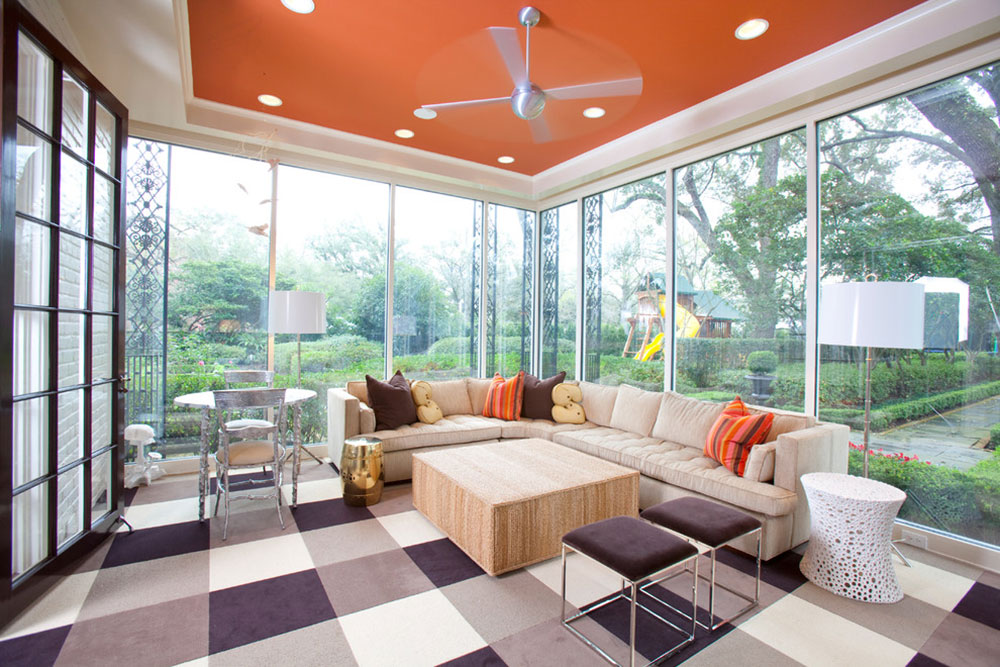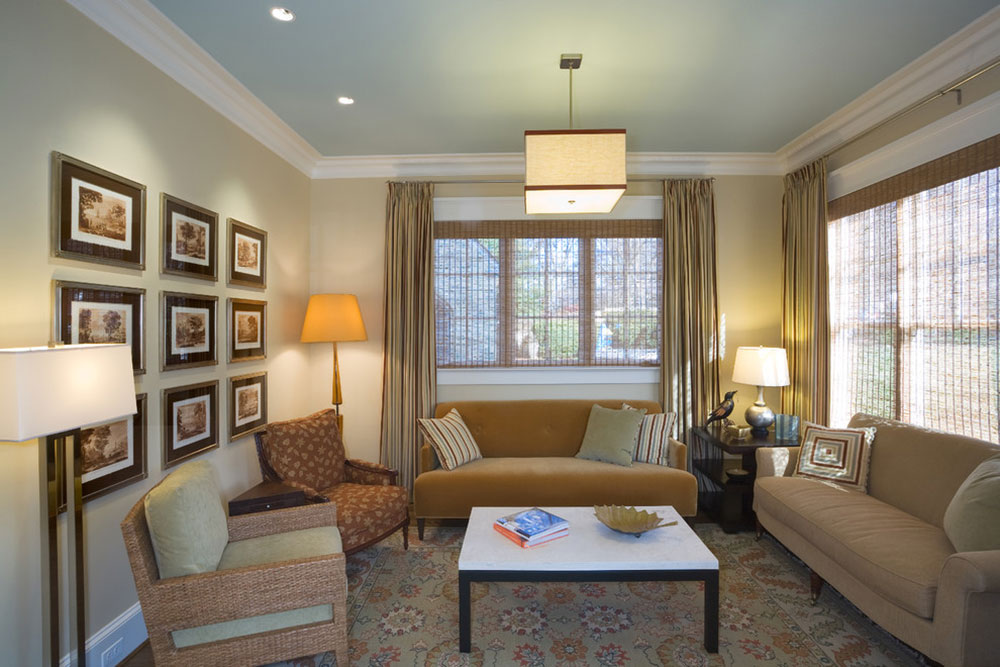Painting your rooms requires serious thought about the effects you want to achieve and the audience that should be impressed. Social experiences play an important role in interior design, especially for those who regularly take in people.
Another aspect that needs to be taken into account is the young audience (children and teenagers), as they need a different decor than any neutral and sophisticated program. When painting a room for them, you need to come up with some permanent and vibrant solutions.
Why should the rules for painting ceilings be different? You may think that ceilings aren’t as important as the rest of the walls, but that’s far from the truth. Choosing the best ceiling color can change the overall feel of a room. This is very important when painting your home.

Image source: Tilton coffered ceilings
You are probably wondering: what color should I paint my ceiling?
Should I paint my ceiling white to keep it neutral?
White is indeed the most common choice for a ceiling due to its lightness and grandeur, but that doesn’t make it an overall good solution.
 Image source: Laura U, Inc.
Image source: Laura U, Inc.
Some rooms need added drama or elegance, and this can be achieved with darker ceilings. As mentioned earlier, ceilings have a significant impact on how a room looks and feels.
How do I make the right choice?
Let’s draw your attention to the most important things to consider when painting your ceilings:
Warm them up
 Image source: http://www.christopherrosearchitects.com/
Image source: http://www.christopherrosearchitects.com/
Large rooms with high ceilings are not as warm or cozy and look impersonal despite the effort you put into furnishing, painting, or choosing the right floor. Most of the time, efforts result in a half-empty space and you have no idea what to do next.
In this case, experimenting with deeper shades is allowed, as it will allow you to even out the largest and most open space. We recommend a soft sheen of rich cocoa, pearl or eggshell.
There’s nothing to worry about: there is just enough ceiling-to-floor space, which means that even a darker room won’t spoil the illusion of space you were trying to reach. Even more: you get a bold and beautiful accent piece to grab attention.
With that in mind, consider darker and bolder colors only for ceilings over 8 feet. Dark and low is not a good combination as it creates heavy interiors that are uncomfortable for the eyes and mind.
Light colors make ceilings look higher
 Image source: LK DeFrances & Associates
Image source: LK DeFrances & Associates
The paler a ceiling, the further away it seems to appear, especially when the room has access to plenty of natural light.
This is precisely why the owners of small rooms usually choose semi-gloss or high-gloss white for their ceilings. However, this is a two-bladed knife: it reflects light colors instead of hiding the imperfections and stains of your blankets.
Light preferences
 Image source: SANTAROSSA MOSAIC & TILE CO INC
Image source: SANTAROSSA MOSAIC & TILE CO INC
Of course, choosing a ceiling color that you like is entirely up to you, but you need to consider the type of space you have before doing anything.
The first things to be assessed are spaciousness and “room illusion”, according to which light ceilings are always a better option (they are mandatory even in darker rooms). A good reason to choose shades of light is that they make the ceilings appear higher and the room appear larger.
Light ceilings are good leveling tools that “calm down” rooms filled with dark tones and create a visual connection and uniform flow in every room.
It won’t be obvious at first glance, but guests will definitely understand that there is a natural bond that “holds the place together”. Textured ceilings are also better when they are light, as any darker shade would decrease the strength of their beautiful, rough patterns.
Give wall paints a purpose
 Image source: Martha O’Hara Interiors
Image source: Martha O’Hara Interiors
Both angled and vaulted ceilings look dramatic when you apply the same paint to the walls. The focus automatically shifts from the ceiling to the architectural elements that you want to highlight.
There are many solutions you can apply to high, vaulted ceilings, molded and detailed siding to make them look unique. You can achieve a monochromatic look by applying the same paint to the walls and ceilings, but using cream paints for the cladding.
 Image source: Jane Lockhart interior design
Image source: Jane Lockhart interior design
Rooms with compatible walls and ceilings can also be a bit more contrasting, which is achieved with crowns, baseboards, and chair rails. You can even use the trim to go a little darker to add a more dramatic effect to the surroundings. Even if this solution “lowers” the ceiling, it appears warm and cozy overall.
The importance of light
 Image source: Sroka Design, Inc.
Image source: Sroka Design, Inc.
The point about lighting is that it’s usually positioned downward, and so must we. However, this means that the ceiling will “stay in the shade” which you should consider when choosing colors.
You should choose a balanced tone that is neither too dark nor too light. However, dark tones are acceptable for rooms that have access to plenty of natural light.
Eye cheating
 Image source: Greg Riegler Photography
Image source: Greg Riegler Photography
Look at the 6-12 inches mark around the perimeter of the ceiling and paint it to match your walls. There are many tricks you can use to make the walls look taller and the room look taller than it actually is.
Colorful ceiling solutions for children
 Image source: Artistic Designs for Life, Tineke Triggs
Image source: Artistic Designs for Life, Tineke Triggs
Designing a teen’s room is a challenge, but the good side of the process is that the possibilities are endless. We encourage you to awaken the artist in you and look through your child’s eyes to understand what they want.
This is a “win-win” solution, meaning you use fun painting so children can have fun but not touch at the same time. Paint the ceiling your child’s favorite color, but add some two-tone stripes to keep the space open.
Does simple white ever work?
 Image source: Design Line Construction, Inc.
Image source: Design Line Construction, Inc.
It all depends on the circumstances. Painting an entire ceiling in white is a great solution for rooms where you’ve already worked on eye-catching artwork or intriguing wallpaper. The role of the white blanket would be to focus on these parts rather than on itself.
What you need to keep in mind here is that there are many types of white depending on the undertones and different responses to daylight. For example, you can buy “warm ceiling white” from many well-known paint brands, a specially made self-priming paint that looks rich and beautiful even with one coat.
Ceiling murals
 Image source: Dreamstar Custom Homes
Image source: Dreamstar Custom Homes
Murals are great for creative and brave people who can paint them themselves or hire professional help. Murals should cover ceilings in reception rooms, as they “behave” as challenging conversation stimuli.
Wondering if murals would attract attention? Take the Sistine Chapel as an example! Of course, we don’t expect you to be Michelangelo and create something as great as the creation of Adam, but some of your personal inspiration can have a great effect too.
 Image source: Solara Designs, Inc.
Image source: Solara Designs, Inc.
Plus, there are plenty of affordable replicas of famous murals that are of comparable museum quality while being easy to glue and pill.
Make sure that special blankets look special
 Image source: Julian’s Interiors
Image source: Julian’s Interiors
The reason we choose lattice or coffered ceilings is because of the potential to use color in an attractive way. Instead of making your ceiling white, you can do so with the raised grille and “coordinate” the inner part with your walls. Once you’ve applied stained wood to the siding / ceilings, paint the interior trim white for an interesting contrast.
 Flower Love
Flower Love
